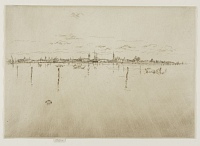The Little Venice | ||
| Number: | 238 | |
| Date: | 1880 | |
| Medium: | etching | |
| Size: | 185 x 264 mm | |
| Signed: | butterfly at lower left | |
| Inscribed: | no | |
| Set/Publication: | 'First Venice Set', 1880 | |
| No. of States: | 2 | |
| Known impressions: | 54 | |
| Catalogues: | K.183; M.180; W.149 | |
| Impressions taken from this plate (54) | ||
TECHNIQUE
The plate is executed in pure etching. The first and second states show the extensive scraping Whistler employed to tidy up the plate (). Later impressions were printed with a light, carefully wiped surface tone of ink, to augment the colour and atmospheric effect of oily stillness of the lagoon.
PRINTING
Over 50 impressions have been located. Unusually, there is a contemporary record of the artist's procedure while working on this etching. According to Way:
'[Whistler] brought back the plate of the "Little Venice", only drawn with the needle. ...This plate I saw him bite in, holding it in one hand and moving the acid about with a feather, and without any stopping out. The first impression of it printed was satisfactory, and he did not need to rebite or reduce any part of it, which, considering that it must have been at least two months, perhaps far more, since he drew it, showed not only wonderful skill in biting, but an amazing memory as well.' 13
One of the earliest proofs remained in the artist's possession: it was printed in black ink - with prominent burnishing marks - on thin, almost translucent 'antique' (pre-1800) laid paper (). This was followed by two impressions in black ink, one on Asian wove 'vellum-surfaced' paper (), another with an inscription by Frederick Wedmore (1844-1921), 'Trial Proof by Whistler from finished plate, a most perfect impression' (), and one on heavy-weight ivory laid western paper ().
Most impressions were in the second state, as printed for the Fine Art Society. Letters, lists, invoices and receipts document Whistler's edition of the twelve etchings of the 'First Venice Set' for the F.A.S. He delivered twenty impressions of The Little Venice on 16 February and three on 25 August 1881; one on 29 January and three on 7 February 1882. 14
14: F.A.S. to Whistler, 20 December 1888, GUW #01217.
The earliest of these, usually signed with a large, veined butterfly, within the margin, were mostly printed in black ink () although a few are in dark brown ink (). Papers include cream wove (, ); off-white laid (); ivory Japan (); glossy simile-Japanese ivory wove (); ivory wove () and smooth cream wove paper ().
He continued to print a few impressions as requested or as the mood took him. He delivered three on 9 April and one on 18 April 1883; two on 8 August 1883; three on 15 February 1884; one on 1 February, three on 20 July and eight on 29 July 1885. 15
15: Ibid.
By 1886, Whistler was busy printing the 'Second Venice Set' for Messrs Dowdeswell. On 18 November 1886 Ernest George Brown (1853/1854-1915) gently reminded Whistler of his obligations to the F.A.S. by asking for nine more impressions of The Little Venice. 16 It was 13 January 1887 before he received them, but Whistler went on to deliver another eleven on 25 June 1887.
16: GUW #01181.
These impressions were trimmed to the platemark and signed on the tab with a butterfly and 'imp.' to show that Whistler had printed them. They show marked similarities to impressions of the 'Second Venice Set' printed at the same time, with careful inking and wiping of plate tone. Most were still printed in black ink; papers included off-white 'Pro Patria' watermarked laid paper (); 'WW' countermarked ivory laid (); ivory laid (); medium-weight 'antique' () and thin transparent ivory 'antique' laid paper (). Those in dark brown ink included impressions on laid () and 'antique' cream 'Pro Patria' watermarked laid paper ().
Two years later he delivered fourteen impressions on 13 March 1889 and finally, one on 2 April 1889. 17 A few of these late impressions were printed in black ink, one on ivory laid paper with 'WW' countermark (); and one on ordinary ivory laid paper (). Most late impressions were printed in dark brown ink, on various laid papers, buff 'antique' laid (); ivory laid (, ); lightweight cream () and watermarked cream laid paper (). Two bear a Hunting horn in shield watermark (, ), the latter being an addition to the F.A.S. edition, kept by the artist.
17: GUW #01219.
On 15 April 1889 the Fine Art Society must have been immensely relieved as they acknowledged receipt of the destroyed plate. 18 Curiously, there are eight impressions from the cancelled plate, printed in dark brown ink. Two are on similar cream Asian laid paper (, ). Two are on western paper, one on cream laid (), and one, kept by Whistler, on cream laid paper with a hunting horn watermark (). Three are on Japanese paper, tan () and cream (, ). Usually only a couple of cancelled impressions were needed to show clients that the edition was completed. Why there are so many is a mystery - unless some assistant simply wanted to practise print-making.
18: GUW #01219.
